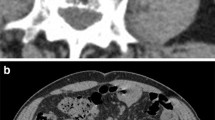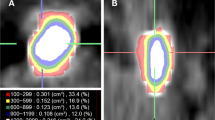Abstract
The purpose of this study was to evaluate whether computed tomography (CT) parameters can predict the success of ureteroscopic lithotripsy (URSL) and establish a model for predicting the success rates of a single URSL procedure for the treatment of a single ureteral stone. We retrospectively reviewed the records of 237 patients who underwent URSL for ureteral stones diagnosed by CT between January 2009 and June 2012. Stone-free status was defined as the absence of stones or residual stone fragments <2 mm by ureteroscopy and plain abdominal radiography. We analyzed the correlations between the outcome of URSL and the patients’ sex, age, height, body weight, body mass index, and history of ureteral stone. Stone factors such as the diameter (D), stone height (H), volumetric stone burden (VSB; D 2 × H × 5 mm × π × 1/6), estimated stone location (ESL; number of axial cut images between the stone and uretero-vesical junction), tissue rim sign (RS; 0–3), perinephric edema (0–3), hydronephrosis (0–3), and Hounsfield unit (HU) were also analyzed. We then developed a model to predict the probability of successful URSL by applying a logistic model to our data. The success rate of URSL was 85.7 % (203/237). Univariate analysis found that stone diameter, length, VSB, ESL, HU and RS significantly affected the stone-free rate. Multivariate analysis indicated that stone diameter, ESL and RS independently influenced the stone-free rate. The logistic model indicated that success rates = 1/[1 + exp{−6.146 + 0.071(D) + 0.153(ESL) + 1.534(RS)}] with an area under the receiver operating characteristic curve of 0.825. Stone diameter, ESL, and RS were independent predictors of the outcome of a single URSL for a single ureteral stone.

Similar content being viewed by others
Abbreviations
- CT:
-
Computed tomography
- URSL:
-
Ureteroscopic lithotripsy
- UHCT:
-
Unenhanced helical computed tomography
- ESWL:
-
Extracorporeal shock wave lithotripsy
- RS:
-
Tissue rim sign
- BMI:
-
Body mass index
- VSB:
-
Volumetric stone burden
- ESL:
-
Estimated stone location
- UVJ:
-
Uretero-vesical junction
- UPJ:
-
Uretero-pelvic junction
References
Miller OF, Rineer SK, Reichard SR, Buckley RG, Donovan MS, Graham IR, Goff WB, Kane CJ (1998) Prospective comparison of unenhanced spiral computed tomography and intravenous urogram in the evaluation of acute flank pain. Urol Gold J 52(6):982–987
Pfister SA, Deckart A, Laschke S, Dellas S, Otto U, Buitrago C, Roth J, Wiesner W, Bongartz G, Gasser TC (2003) Unenhanced helical computed tomography vs intravenous urography in patients with acute flank pain: accuracy and economic impact in a randomized prospective trial. Eur Radiol 13(11):2513–2520
Smith RC, Verga M, Dalrymple N, McCarthy S, Rosenfield AT (1996) Acute ureteral obstruction: value of secondary signs of helical unenhanced CT. AJR Am J Roentgenol 167(5):1109–1113
Ege G, Akman H, Kuzucu K, Yildiz S (2003) Acute ureterolithiasis: incidence of secondary signs on unenhanced helical CT and influence on patient management. Clin Radiol 58(12):990–994
Bewick V, Cheek L, Ball J (2005) Statistics review 14: logistic regression. Crit Care 9(1):112–118
Goodman TM (1977) Ureteroscopy with pediatric cystoscope in adults. Urol Gold J 9(4):394
Lyon ES, Kyker JS, Schoenberg HW (1978) Transurethral ureteroscopy in women: a ready addition to the urological armamentarium. J Urol 119(1):35–36
Grasso M (2000) Ureteropyeloscopic treatment of ureteral and intrarenal calculi. Urol Clin North Am 27(4):623–631
Wolf JS Jr (2007) Treatment selection and outcomes: ureteral calculi. Urol Clin N Am 34(3):421–430
Abdelrahim AF, Abdelmaguid A, Abuzeid H, Amin M, el Mousa S, Abdelrahim F (2008) Rigid ureteroscopy for ureteral stones: factors associated with intraoperative adverse events. J Endourol 22(2):277–280. doi:10.1089/end.2007.0072
Assimos DG, Boyce WH, Furr EG, Espeland MA, Holmes RP, Harrison LH, Kroovand RL, McCullough DL (1989) Selective elevation of urinary enzyme levels after extracorporeal shock wave lithotripsy. J Urol 142(3):687–690
Boulay I, Holtz P, Foley WD, White B, Begun FP (1999) Ureteral calculi: diagnostic efficacy of helical CT and implications for treatment of patients. AJR Am J Roentgenol 172(6):1485–1490
Takahashi N, Kawashima A, Ernst RD, Boridy IC, Goldman SM, Benson GS, Sandler CM (1998) Ureterolithiasis: can clinical outcome be predicted with unenhanced helical CT? Radiology 208(1):97–102
Seitz C, Memarsadeghi M, Fajkovic H, Tanovic E (2008) Secondary signs of non-enhanced CT prior to laser ureterolithotripsy: is treatment outcome predictable? J Endourol 22(3):415–418
Magnuson WJ, Tomera KM, Lance RS (2005) Hounsfield unit density accurately predicts ESWL success. Alask Med 47(2):6–9
Imamura Y, Kawamura K, Sazuka T, Sakamoto S, Imamoto T, Nihei N, Suzuki H, Okano T, Nozumi K, Ichikawa T (2013) Development of a nomogram for predicting the stone-free rate after transurethral ureterolithotripsy using semi-rigid ureteroscope. Int J Urol 20(6):616–621
Resorlu B, Unsal A, Gulec H, Oztuna D (2012) A new scoring system for predicting stone-free rate after retrograde intrarenal surgery: the “Resorlu–Unsal stone score”. Urology 80(3):512–518
Conflict of interest
The authors declare that they have no conflict of interest.
Author information
Authors and Affiliations
Corresponding author
Rights and permissions
About this article
Cite this article
Kim, J.W., Chae, J.Y., Kim, J.W. et al. Computed tomography-based novel prediction model for the stone-free rate of ureteroscopic lithotripsy. Urolithiasis 42, 75–79 (2014). https://doi.org/10.1007/s00240-013-0609-0
Received:
Accepted:
Published:
Issue Date:
DOI: https://doi.org/10.1007/s00240-013-0609-0




